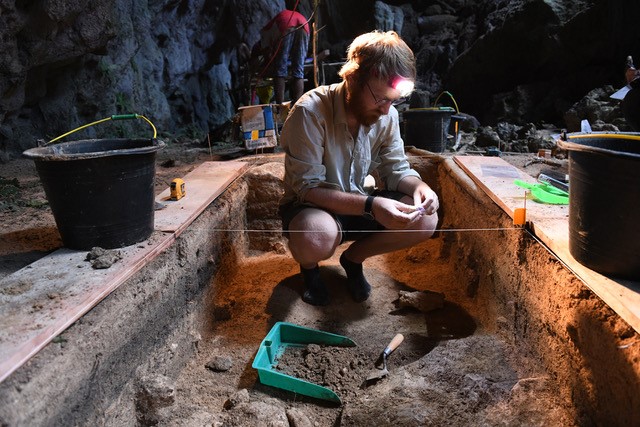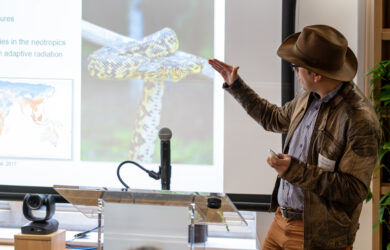
Dylan Gaffney talks about his pioneering research in the Raja Ampat Islands of West Papua.
I want to know what enabled our species, Homo sapiens, to disperse to a wide variety of new and challenging ecological settings while the Neanderthals and other hominins stayed in more favourable habitats.
Dylan Gaffney
Dylan Gaffney’s research investigates the crucial link in our understanding of how ancient humans initially migrated through Island Southeast Asia into the Pacific and how they adapted to thrive on small rainforested islands.
He says: “I want to know what enabled our species, Homo sapiens, to disperse to a wide variety of new and challenging ecological settings while the Neanderthals and other hominins stayed in more favourable habitats.”
Dylan’s research focused on the Raja Ampat Islands, West Papua, which had not been previously excavated despite its strategic importance linking Indonesia and New Guinea, the gateway to the Pacific. “They connect different stories of the human past. We know a lot about Indonesia and New Guinea’s history, but not about what connects the two island worlds,” he says.
Dylan [2017], who is doing a PhD in Archaeology, organised six months of fieldwork before Covid, funded by National Geographic, the Leakey Foundation, and the University of Cambridge. This fieldwork included a survey of the islands with local collaborators which involved taking boats around the coast and trekking inland in search of caves and middens – following the natural geography and geology of the area and assisted by expert local guides. In a place where no excavation had taken place, they located 150 sites which might yield important archaeological evidence such as shells, pottery or stone artefacts.
Dylan’s group followed up with an excavation of three cave sites with archaeologists from Papua and Indonesia as well as local stakeholders and students. They found fossils, artefacts and organic remains which Dylan has been able to analyse back in Cambridge. The data is the earliest information to date of human migration to the Pacific, which occurred over 50,000 years ago.
The group also found evidence from the Neolithic period, a time when seafarers from Asia moved to Indonesia, New Guinea and later Polynesia, bringing with them pottery making and new food and animal types, including dogs, chickens and pigs.
Choosing archaeology
Dylan himself understands island life, having been born in Dunedin, New Zealand. His father is a lecturer working in education. His mother works in the zoology department.
At primary school he was not especially academic and focused more on sport, but all that changed in high school. Dylan found it hard to narrow down his interests, however, taking art, graphic design, English literature, statistics, physics, Latin, and classical studies in his final years. When he finished school he had decided he would either be an archaeologist or an architect.
In his first year at the University of Otago he majored in design studies and classical studies, unable to choose, but the design department then closed, a victim of cuts in the humanities, and his decision was made for him.
Dylan did a four-year degree – a BA in Classical Studies and Anthropology, followed by an honours year in Anthropology which involved a dissertation that initiated his fascination for understanding the evolution of human life in Southeast Asia and the Pacific.
He studied Ice Age stone tools which had been dug up in Papua New Guinea in the 1960s in the first excavation of Papua New Guinea by the pioneering archaeologist Sue Bulmer. Dylan re-examined the tools using modern technology. His study challenged the idea that people had transitioned smoothly from hunter gatherers in the Ice Age to agricultural production, suggesting instead that hunter gathering persisted for thousands more years into the Holocene (our current warm period) alongside other practices and ways of life.
For his two-year master’s he decided to stay at the University of Otago. His supervisors, Professor Glenn Summerhayes and Dr Anne Ford, were very supportive and well regarded in the region and he was able to take part in an excavation project in New Guinea, looking at how pottery making had changed from the 15th century onwards. Dylan was given a great deal of freedom to explore the issues of interest to him and gained valuable experience in everything from radiocarbon dating to project management. “It was like an apprenticeship,” he says.
Halfway through his master’s degree Dylan was offered a full-time job working as Research Coordinator with Southern Pacific Archaeological Research, an archaeological and heritage consultancy which promotes best practice in archaeological, historic and cultural heritage management. He spent his days working there, doing excavation mapping and preparing reports on a range of industrial development projects, and his evenings finishing his master’s.
Doctoral research
He decided that, for his PhD, he wanted to travel to Europe due to its rich heritage and history and because he had always been fascinated by ancient Greece and Rome. He applied to three universities and was swayed to pick Cambridge after he was awarded a Gates Cambridge scholarship. Originally he had hoped to work on an ancient Greek project, but a desire to break new ground with fieldwork led him back to Southeast Asia.
He had two PhD supervisors, Professor Cyprian Broodbank, a specialist in island archaeology, and Professor Graeme Barker, who has focused on early human migration to rainforest settings, both of whom helped orient his research.
Dylan is now writing up his research and hopes to publish various academic papers over the next year when he takes up a Junior Research Fellowship at St John’s College, Oxford. He is also keen to make his research more accessible to people other than experts and received funding to do a digital outreach project.
Usually he does community presentations and he hopes to do that in the future, but during Covid that has not been possible. The website was published in Indonesian and English so that both international audiences and West Papuans could learn about the project. “I feel that the project would be incomplete without that outreach to people outside academia. I do think that is part of the whole research package,” says Dylan.
He has had a good response to the project from both the public and from archaeologists. The Raja Ampat Islands have become a hub for eco-tourism, being the most marine diverse place in the world, and many want to learn about the history of the region.
Dylan says being able to excavate in previously unknown territory archeologically speaking has been exciting. “It was a real privilege,” he states. “I have been fortunate to work alongside brilliant communities in the Raja Ampat Islands and exceptional local counterparts to do cutting edge research.”












